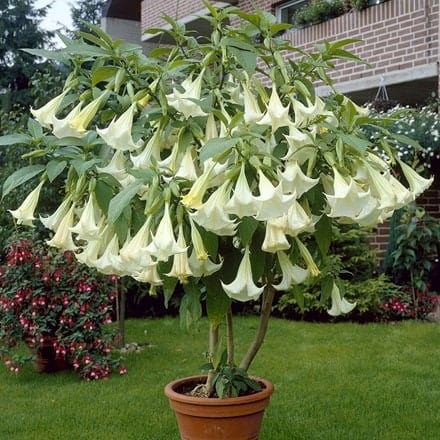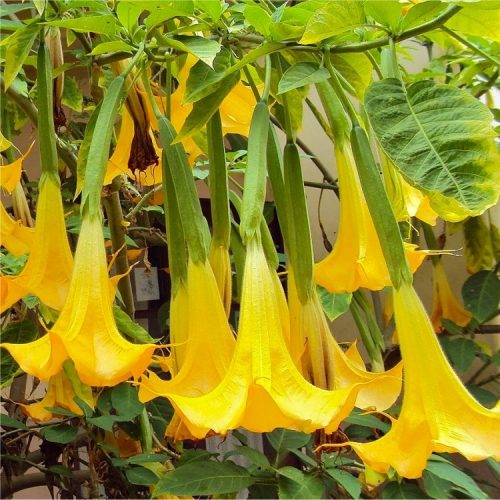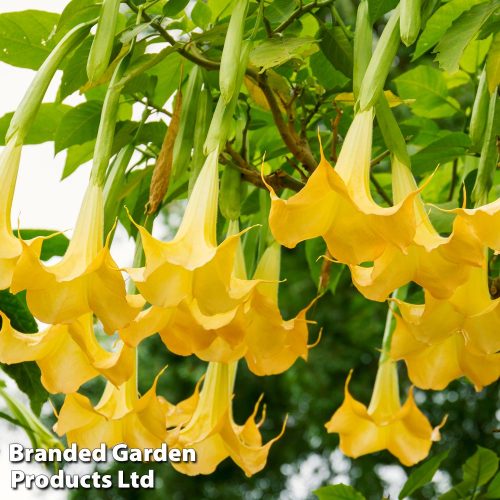Brugmansia plants are dramatic tropical shrubs or small garden trees that are easy to grow and easy to maintain. They can grow well on their own and don’t need much attention or perfect growing conditions. They can be damaged by low temperatures if not properly protected from frost, but will often still survive to grow again the next year.

Brugmansia
Certain precautions and care conditions should be noted when growing Brugmansia however, as Brugmansia (formerly Datura) is toxic when ingested so should be kept out of reach of children and pets, and as an outdoor plant,
IN THIS ARTICLE
Basic Care Of Brugmansia Plants
How much water does a Brugmansia need?
Brugmansia is a thirsty plant and needs to be watered frequently and thoroughly, however, they do not like being left in soggy soil. To satisfy the water needs of a Brugmansia plant, you need to achieve a fine balance between keeping the soil consistently moist but not soggy. Overwatering can cause root rot and also cause the leaves of the plant to start wilting and turn yellow.
Light Requirements for Brugmansia
Brugmansia plants are best planted in a position where they can get full sun and be shaded from the hot afternoon sun. Though angel’s trumpet plants are full sun lovers and can comfortably take the full sun, they should be given some shade in regions where the summers are especially hot and dry.
When growing Brugmansia indoors, they should be placed close to a window or in a position where they can get enough exposure to sunlight.
Flowering and Blooming – why is my Brugmansia not blooming?
Brugmansia plants make a statement because of their large, pendulous, trumpet-shaped flowers so when your flower is not blooming it is a great cause for concern. Depending on the species, the propagation methods, and the growing conditions, it can take Brugmansia plants as little as 3 years and sometimes as long as 5 years before you see the first bloom.
Whether grown in full sunlight or partial shade, Brugmansia will bloom beautiful flowers. Some species may bloom better in sunlight while others bloom better with partial shade. Bloom may also be affected by water and fertiliser problems.
Winter Care – Overwintering brugmansia
Brugmansia plants are not a hardy species, and most will not survive through the winter when growing outdoors without proper overwintering care. In the UK, Brugmansia plants are supported by favourable temperature and humidity levels for some part of the year. If the temperatures drop below 4 degrees celsius, precautions should be taken to ensure your plant survives.
For container plants, move them indoors and only put your Brugmansia plants outside when all signs of frost are gone, and the temperature levels are above 5 degrees celsius.
However, some people in the UK do leave their Brugmansia in the ground, and it can survive a mild winter if in a protected spot. With a good mulch over, the roots may come through the winter OK and continue to grow the next year. But, to be honest if you dig them up and keep somewhere warm through the winter they will continue to flower for bit longer! I usually just drag them back in to the poly tunnel each winter (saying that, I do still have outside and mulched in the garden in Feb)
Brugmansia Toxicity
Brugmansia trees are extremely poisonous but are safe to grow when kept out of reach of children and pets. There are no dangers in touching or smelling Brugmansia plants but ingesting it can lead to several problems including confusion, hallucination, hyperthermia, and death. All species of the Brugmansia genus are extremely poisonous to humans and all parts of Angel’s trumpet eaten in any proportion can lead to serious consequences.
Angel’s Trumpet and Datura
Angel’s trumpet was formerly grouped in the same genus as Datura until 1973 when T.E Lockwood released a detailed comparison of the two genera and placed Brugmansia in a separate genus from the Datura genus. The most significant and identifiable difference between Datura and Brugmansia is that the flowers of Datura trees are upright, facing upwards while those of Brugmansia are downward facing, hanging like a pendulum. The two plants are called commonly called opposites, nicknaming Brugmansia as angel’s trumpets and Datura as devil’s trumpet because of the shapes of their flowers.
Though Moonflower is often called an angel’s trumpet, it is a member of the Datura genus and the only Datura plant that is called an angel’s trumpet.
A similarity between the Datura and Brugmansia genus is that both are toxic and ingesting any amount, part, or species of both can lead to serious consequences including death.
Frequently Asked Questions On How To Care For Brugmansia
Are angel’s trumpet roots invasive?
Not all species of angel’s trumpet have invasive roots. They can grow as deep as 9 inches below ground level and will likely continue growing after cutting off the top of the tree.
How tall do Brugmansia grow?
Brugmansia trees are referred to as small trees or large shrubs. They can grow as tall as 15 to 36 feet when grown outdoors. In the UK however they will grow over a couple metres, 12ft+
How fast does Brugmansia grow?
They are extremely fast-growing plants especially when grown in the right conditions. They grow much faster and produce healthy colourful blooms when they are fed with a balanced liquid fertiliser at least once a week. A Brugmansia tree can grow to reach 9 feet in just 3 years.
Is Brugmansia easy to grow?
They are very easy to grow regardless of the weather conditions in your region. They can be grown outdoors on the ground or indoors in containers.
Why are my Brugmansia leaves turning yellow?
You Brugmansia plants may develop yellow leaves because of overwatering, or when it is being attacked by pests and diseases such as spider mites.
How often should I water my angel trumpet?
They are thirsty feeders and should be watered every couple of days in the hot summer months and reduced to a necessary basis to keep the soil moist in winter.












